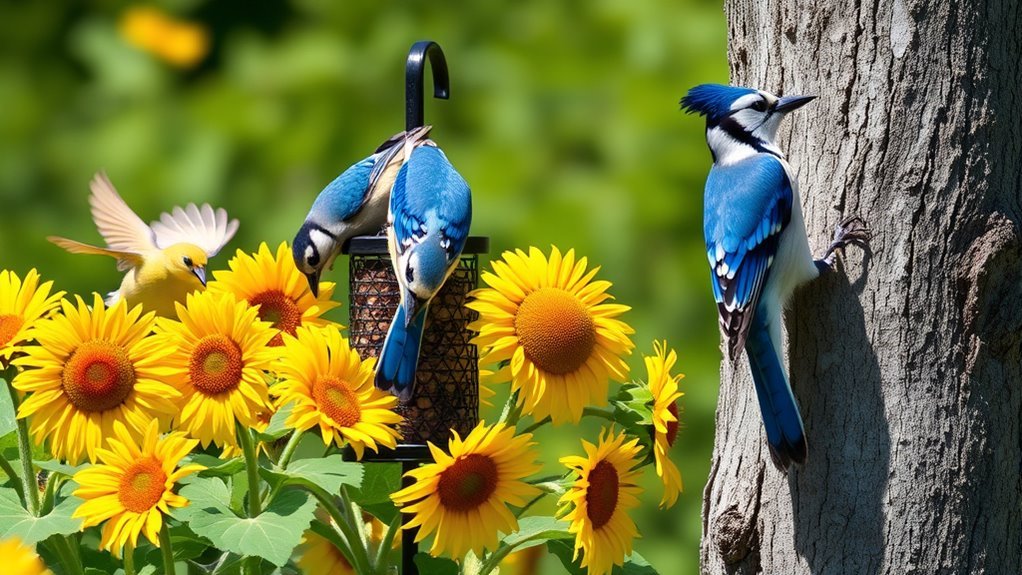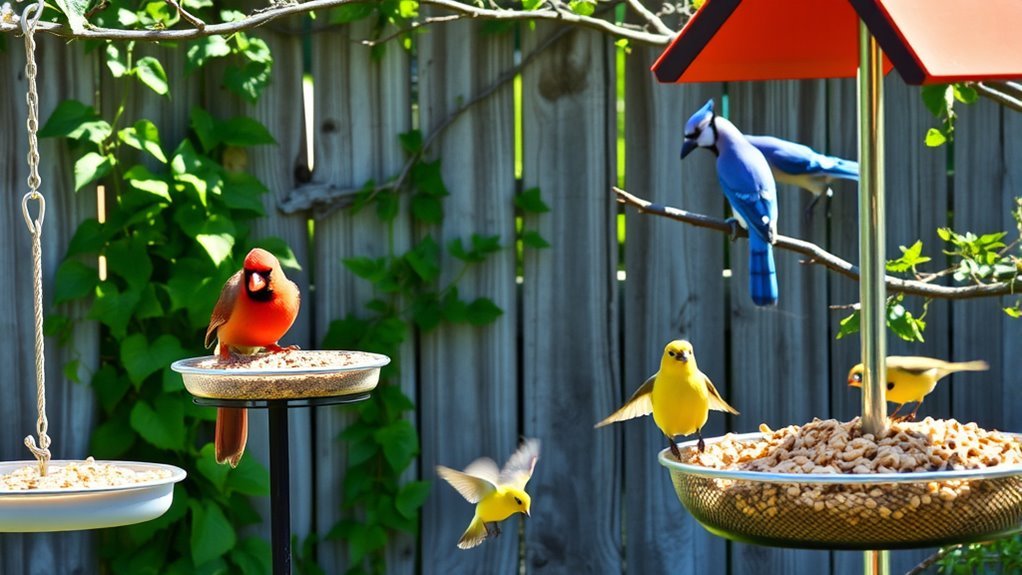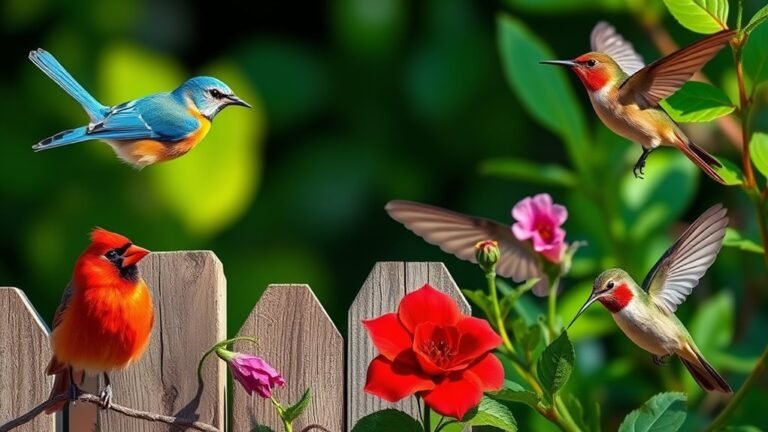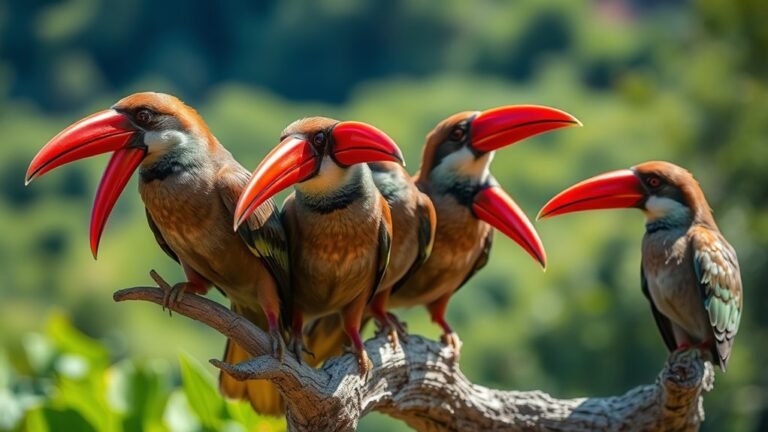Massachusetts Backyard Birds
In Massachusetts, your backyard can become a lively home for many bird species. You will see birds like the colorful American Robin and the cheerful Eastern Bluebird. Watching their behaviors and interactions with nature can enrich your outdoor time. If you want to attract more birds and connect with nature, several simple strategies can help.
Key Takeaways
- Common backyard birds in Massachusetts include the American Robin, Eastern Bluebird, and House Sparrow.
- Birds often forage for food in shrubs or on the ground throughout local landscapes.
- Proper bird feeding practices involve using fresh seeds and maintaining clean feeders to prevent mold.
- Incorporating native plants such as milkweed and coneflower helps attract diverse bird species to your yard.
- Engaging in birdwatching activities fosters appreciation for local wildlife and enhances observation skills.
Common Backyard Birds in Massachusetts

In Massachusetts, you can find many types of birds in your backyard. Common species include the American Robin, Eastern Bluebird, and House Sparrow. These birds add to the area's diversity and often search for food in shrubs or on the ground.
To improve your birdwatching experience, stay still and quiet. This will help you see their natural behaviors. A pair of binoculars is useful for getting a closer look at features like the robin's bright orange breast.
Observing these birds will help you connect more deeply with nature and appreciate your surroundings. Enjoy watching and learning about the birds in your area!
Seasonal Migration Patterns
As temperatures drop in Massachusetts, many bird species start their seasonal migrations. They travel thousands of miles to find warmer climates. The timing of migration varies by species and is affected by climate changes.
For example, warmer weather may cause birds to leave earlier, while changes in food availability can delay their departure.
Watching these migrations connects you to nature and shows how birds interact with their environment. Look for flocks of geese or robins flying south. Their movements are driven by instinct and necessity.
Your backyard offers a view of this amazing journey, allowing you to appreciate avian life during seasonal changes.
Bird Feeding Basics

After migration, many birds return to Massachusetts looking for food to help them through the colder months.
To help these birds, you should focus on feeding them safely. Always use fresh, high-quality bird seed, and avoid harmful foods like stale seed or bread. Check your feeders regularly to keep them clean and free from mold or pests. Good maintenance of your bird feeders is essential for attracting healthy birds.
Providing fresh water is also important, so think about adding a birdbath. By offering consistent food and a safe, clean environment, you can create a welcoming space for birds. This will enhance your connection to nature and fellow bird lovers.
Your backyard can become a beautiful sanctuary for wildlife.
Top Bird Feeders for Your Yard
Choosing the right bird feeder can greatly improve your backyard's appeal to different bird species in Massachusetts. Start with tube feeders for small songbirds like finches. They enjoy black oil sunflower seeds, which are among the best options.
Use platform feeders to attract larger birds; these allow easy access to mixed seeds and fruit. Suet feeders are important too, especially in colder months when birds need more energy.
To keep birds coming back, maintain your feeders regularly. Clean them every two weeks and refill them consistently. This practice creates a clean feeding space, reducing the risk of disease and attracting more birds.
Pay attention to how different species react to your feeders. By choosing the right feeders and caring for them well, you'll create a lively habitat filled with a variety of colorful birds, enhancing your backyard experience.
Attracting Birds With Native Plants

To attract a variety of birds to your backyard in Massachusetts, use native plants in your garden.
Native plants play a key role in supporting local ecosystems by providing food and shelter for birds. For example, milkweed, coneflower, and oak offer vital nectar, seeds, and insects that improve habitat diversity.
Watching birds interact with these plants can deepen your appreciation for nature. You might see goldfinches enjoying coneflower seeds or hummingbirds visiting bee balm.
Creating a Bird-Friendly Habitat
To create a bird-friendly garden, start with native plants. These plants form the base of a healthy habitat for birds. Use a variety of grasses, shrubs, and trees to offer food and shelter. Native berries, seeds, and nectar provide essential nutrition for birds.
Include water features, like birdbaths, to give birds a place to drink. Dense plants also create safe nesting spots.
Reduce pesticide use and let plants grow naturally to support local wildlife. Focus on creating a space that's enjoyable for both birds and people.
Watching birds thrive enriches your garden experience. By following these easy steps, you'll build a welcoming sanctuary for birds in your yard.
Essential Birdwatching Gear
Starting your birdwatching journey is exciting, and the right gear makes your experience better. A quality pair of binoculars is necessary. Brands like Nikon and Zeiss have great optics that help you see distant birds clearly.
Look for binoculars with 8x to 10x magnification for good clarity and stability.
Using a birdwatching app, like Merlin Bird ID or eBird, can make identifying birds and tracking your sightings easier. These apps connect you with other birdwatchers, creating a sense of community.
Don't forget to bring a notebook to write down your observations and make sketches. This practice improves your skills and helps you connect more with nature.
Enjoy your birdwatching adventures!
Birdhouse Designs for Massachusetts Species
Setting up a birdhouse for Massachusetts birds requires attention to their specific needs. Choose untreated wood, like cedar or pine, for the best results. This material offers natural insulation and maintains a stable temperature inside the birdhouse.
Design the entrance hole based on the bird species you want to attract. Bluebirds need a 1.5-inch opening, while chickadees prefer smaller holes. Ensure the birdhouse has good ventilation and includes drainage holes for moisture control.
Install the birdhouse 5 to 10 feet off the ground and position it away from strong winds. This placement will enhance safety for the birds.
With thoughtful construction, your birdhouse can become a welcoming home for local wildlife. Enjoy watching the vibrant birds visit your backyard!
Understanding Bird Behavior
Understanding bird behavior involves observing patterns and responses to their environment. Bird communication is important for social interactions and survival. Birds use calls, visual displays, and body language to convey messages, especially when a predator is nearby or when seeking a mate.
Nesting habits show how birds adapt to their surroundings. Some birds nest in cavities or dense shrubs, while others build open nests. Their choice of materials and building methods protects and insulates their eggs.
Identifying Birds by Song
Identifying backyard birds by their songs is a rewarding experience. Each bird species has its own distinct vocalizations. Learning these songs helps you connect with nature and recognize which birds are in your yard.
For example, listen for the cheerful trill of the American Robin or the unique whistle of the Eastern Whip-poor-will. Some birds, like the mockingbird, can mimic the calls of others.
The Importance of Bird Conservation
Bird songs enhance your outdoor experience and underscore the need for bird conservation.
You may observe fewer birds as cities expand and natural habitats shrink. By safeguarding areas like wetlands and forests, you help maintain the balance in ecosystems that various species rely on.
Each bird song serves as a reminder of the essential roles these creatures fulfill, such as managing insect populations and pollinating plants.
Participating in local conservation initiatives can build community connections.
Simple steps, like planting native plants in your yard, significantly aid habitat preservation.
Together, we can create safe spaces for birds and ensure that future generations can enjoy their melodic calls.
Engaging Kids in Birdwatching
Engaging kids in birdwatching can spark their interest in nature and help them appreciate wildlife. Start with easy birdwatching activities, such as watching and identifying local birds in your yard or nearby parks.
Give your children binoculars and a bird field guide to enhance their experience. Encourage them to keep bird journals where they can draw birds, write about colors and behaviors, and track their favorites.
Make it exciting by creating scavenger hunts for different bird species. Celebrate their discoveries together, building a sense of connection to nature and the birding community.
This hands-on approach develops observation skills and nurtures a lasting love for the environment in your young birdwatchers.
Resources for Bird Enthusiasts
As your kids grow interested in birdwatching, there are many resources to help them learn about and enjoy birds.
Birdwatching apps can provide instant identification and details about birds found in Massachusetts. These apps promote observation skills and help them log their sightings.
Joining local birding clubs is another great option. These clubs connect your family with other bird lovers. They often organize trips, workshops, and community events.
This creates a sense of community and shared learning. Your kids can learn from experienced birdwatchers, expanding their knowledge and appreciation for birds.
Use these resources to support your children's love for birds!
Frequently Asked Questions
What Are the Best Times of Day to Spot Birds?
To spot birds, go outside early in the morning or in the evening. Birds are most active at these times. They search for food and sing. Watching them during these hours can help you appreciate their behavior and learn more about them.
How Can I Tell if a Bird Is Sick?
To tell if a bird is sick, watch its behavior closely. Look for symptoms like low energy, messy feathers, or strange sounds. Make a checklist of symptoms to help you spot worrying signs. This will allow you to act quickly if needed.
Are There Any Endangered Birds in Massachusetts?
Yes, Massachusetts has endangered birds. Various species are at risk, leading to conservation efforts focused on protecting their habitats and helping them recover. By observing these birds and reporting your findings, you play a crucial role in their survival and increase community awareness.
Can I Keep a Rescued Bird as a Pet?
You cannot keep a rescued bird as a pet without special training and permits. Owning a bird requires knowledge about its needs and the legal rules. Make sure you can give the bird the right care and environment it needs.
What Impact Do Cats Have on Local Bird Populations?
Cats significantly affect local bird populations by hunting and killing them. This predation can lead to a decline in bird species. To help protect birds, keep cats indoors. This will create a safer space for birds while allowing you to enjoy their beauty outside.

Hello, I’m Amelia White, the founder of birdsfanatic.com. As a lifelong bird enthusiast and spiritual seeker, I’ve always been fascinated by the mystical connections between birds and the human experience. On this site, I share my knowledge and insights into the symbolic meanings and spiritual significance of various bird species, exploring their roles in mythology, folklore, and cultural traditions. Join me on this journey into the world of birds, where we’ll discover the hidden wisdom and guidance that these magnificent creatures have to offer.






